Hybrid-ging the Gap: 2025 Ford Ranger PHEV Review
The Ford Ranger PHEV (Plug-In Hybrid) represents one of the first serious attempts to present a frugal, more economical option in the rough ‘em, tough ‘em pick-up truck class – can it spark a new trend in the famously fuel-guzzling sector?
Model as Tested: Ford Ranger PHEV Wildtrak
Power: 2.3-litre (Petrol), 11.8kWh (Electric)
Supplied: Vertu Ford Newcastle
Nothing says honest, no-nonsense workhorse quite like a pick-up truck. A utilitarian commercial vehicle on the one hand, a cossetting four-door family car on the other, while pick-up trucks have steadily evolved into lavish – and popular – lifestyle accessories, there is no disguising those hardy origins.
However, while flat-beds, raised ride-heights and beefy bodywork are more fashionable than they’ve ever been, the pick-up truck sector has been slower to move with the times when it comes to electrification.
While big, heavy off-roading pick-up trucks by their very nature are unlikely to ever be the last word in economical motoring, those higher-than-average CO2 emissions figures have been brought into closer scrutiny in the wake of a major change in Benefit-In-Kind (BiK) tax rates for Double-Cab models.
Enter the Ford Ranger PHEV, which proposes reduced carbon emissions figures and the potential to be driven on electric power only to earn itself a much lower BiK tax rate than its diesel-powered rivals.
While this is a step shy of going full-electric (at least for the time being), can the Ford Ranger PHEV’s ‘best of both worlds’ approach be the catalyst for change in the pick-up truck sector?
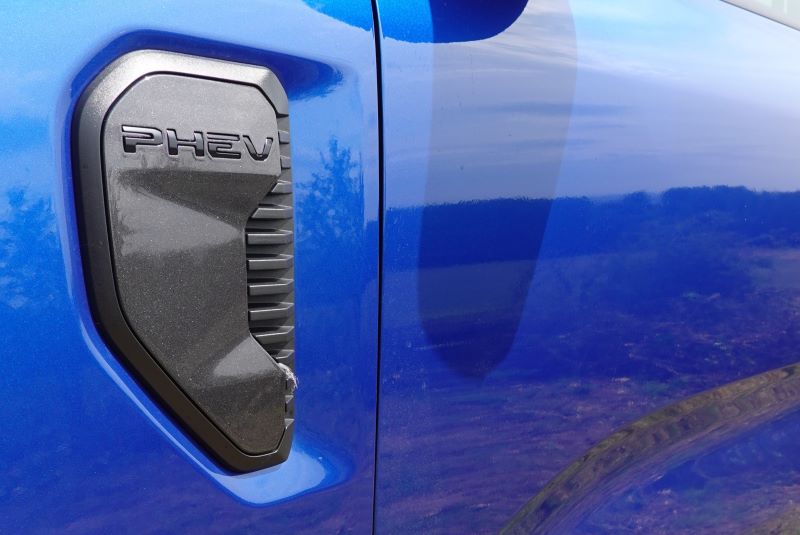
What is the Double-Cab Pick-Up Tax Change?
From April 2025, the erstwhile tax regulation based on payload capacity was scrapped in favour of a new tax classification measured on the number of seats in any vehicle.
Double-Cab Pick-Up vehicles are therefore subject to BIK (Benefit-In-Kind) tax rate using a figure based on CO2 emissions, like a standard company car.
As these models generate higher emissions than most vehicles, taxpayers could be paying out thousands a year more on their car tax if they own a diesel pick-up truck.
What Is the Ford Ranger PHEV’s BiK Tax Rate?
The Ford Ranger PHEV offers some enticing cost savings over equivalent diesel-only pick-up trucks – including other models in the Ranger line-up – courtesy of official CO2 emissions being rated at 71g/km.
While real-world emissions output and fuel economy will largely depend on how you use your Ranger PHEV – electric only, a combination of the two or mostly the petrol engine – it is the crucial WLTP figure that counts towards determining BiK tax rates.
So that 71g/km is very important. It helps to keep BiK company car tax to around £350 a month for 20 per cent rate payers. This compares with £500-plus for diesel-powered models.
For top-rate earners of 37 per cent, the Ranger PHEV Wildtrak will cost around £4,600 a year in tax, well down on more than £7,000 for the equivalent diesel Ranger Wildtrek.
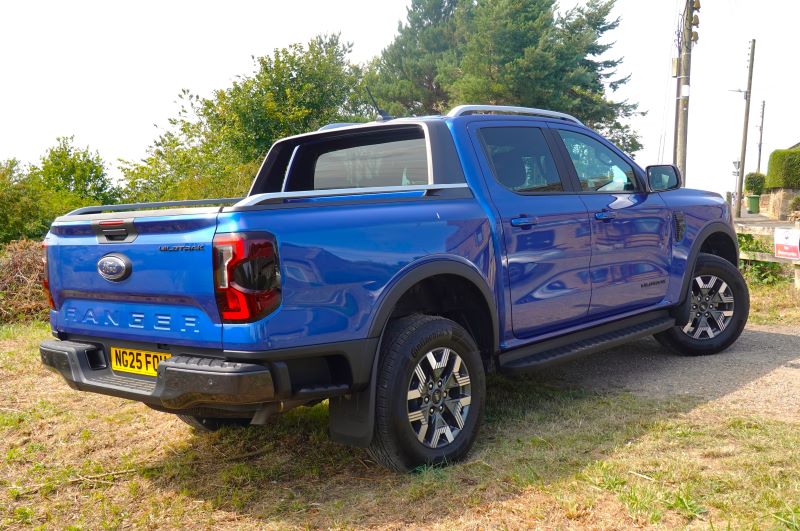
Ford Ranger PHEV Wildtrak – The Direct Verdict
There is a strong business case to make for the Ford Ranger PHEV... and not just because of the cost savings it promises from greatly improved emissions figures and fuel economy. Indeed, perhaps the most remarkable aspect of the plug-in hybrid Ranger is how unremarkable the PHEV powertrain is. This is no criticism, it’s reflective of how seamlessly electric power is integrated into what was already an accomplished package and how it demands barely any discernible compromise over a diesel Ranger.
Lease the Ford Ranger PHEV if...
- You want to reduce your running costs
- Your commute regularly involves low speed environments
- You can easily charge at home or have easy access to recharging facilities
- You frequently tow or would benefit from torquey pulling power
Lease the Ford Ranger PHEV with Vansdirect
Leasing a new Ford Ranger pick-up truck with Vansdirect has never been easier or better value.
Get the right pick-up truck at the right deal, right now with the best Ford Ranger van leasing deals, including diesel and plug-in hybrid models.
Speak to our expert team today and you could be driving a new Ford Ranger for less than you think.
Ford Ranger PHEV: Dimensions, Load Bay & Practicality
Crucially, there is no compromise to practicality and versatility involved with choosing a Ford Ranger PHEV over its diesel counterpart.
Indeed, there is no difference in the key dimensions – length and wheelbase – between the PHEV and other models in the Ranger line-up, which is handy since it is already one of the most spacious and useable pick-ups in its class.
At 5370mm in length, the Ranger is undeniably long, an assumption you’ll confirm upon visiting your local supermarket car park.
The flipside, however, is a spacious load box measuring 1638mm in length at floor level, while it is wide enough to hold a Euro pallet too.
While the Ranger’s load area is already larger than most rivals in its class, it’s the practical touches that single it out as the standard bearer in the pick-up segment.
Whether it’s the rear bumper step to make accessing the cargo bay easier, the (optional) load-management system with cleats and tie-down points keeping your payload stable or a tailgate that can double as a fully-functioning workbench, the Ranger – PHEV or otherwise – is brimming with nifty touches.
It’s spacious inside too, comfortably seating five six-footers with room to spare in terms of knee and headroom. It’s all complemented by folding rear-seats, underfloor storage, a dual glovebox and myriad cup holders too.
| Double Cab | |
| Length | 5370mm |
| Height | 1878mm |
| Wheelbase | 3270mm |
| Load Length | 1638mm |
| Load Width | 1224mm |
| Load Depth | 498mm |
| Max Payload | 1043kg |
| Towing Capacity | 3500kg |
| Gross Vehicle Weight | 3500kg |
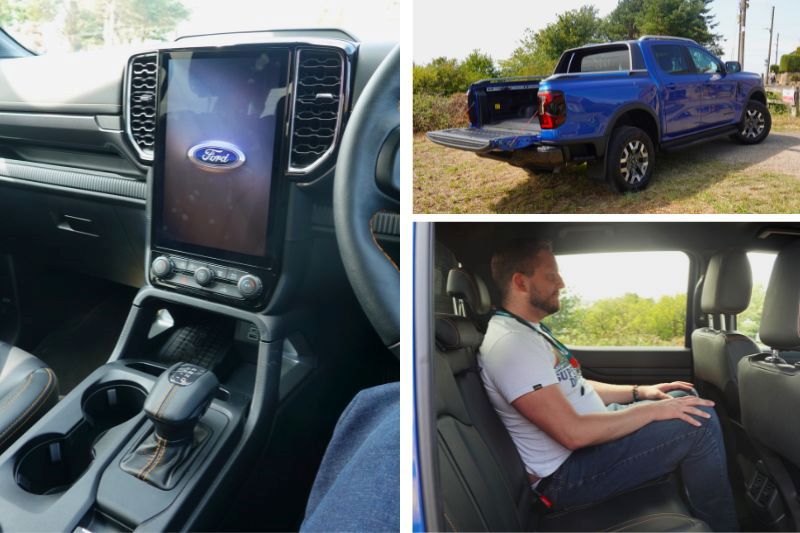
Ford Ranger PHEV: Weights, Payloads & Towing
It’s no coincidence the pick-up segment has been slow on the uptake when it comes to electrification.
For one, many pick-up truck platforms can trace their roots back to a time when the notion of integrating a battery unit wouldn’t have crossed even the most visionary minds.
Moreover, the architecture of a pick-up truck makes adding a comparatively bulky and heavy battery under the load bed a headache as it affects unladen weight distribution.
In this instance, Ford has opted for a modestly sized 11.8kWh battery for the Ranger PHEV generating 75kW to limit the amount of necessary re-engineering to accommodate it. Even so, the 2100kg of rear axle load (compared to 1959kg of diesel models) is indicative of where the ballast has been applied to the PHEV.
The small size of the battery is what ultimately limits the range potential of the Ranger PHEV on the road, but Ford has evidently prioritised payload and towing capacity over outright battery durability.
As such, with gross vehicle weight of 3500kg, the Ranger PHEV all-but-matches its diesel-powered siblings for payload – 1046kg in Wildtrak trim – while there is no change in the class-leading 3500kg available for towing.
Ford Ranger PHEV: Range, Charging & Running Costs
There are obvious limitations to the 26-mile range, though Ford points out that more than half of Ranger owners tend to travel fewer miles than this day-to-day anyway.
While you’ll need to actively select electric-only mode to prevent the engine from kicking in over the top, if your daily commute is regularly around 20 miles or less, there are huge savings to be had from driving fuel and emission-free.
Ultimately, it is this daily use that will determine whether the Ranger PHEV is for you. Over long distances you will rely mostly on the petrol-engine, which means you’ll see relatively little benefit at the fuel pumps.
Use it to its potential and there is scope for fuel economy to be as good as 80mpg, while those significantly reduced emissions of 71g/km – in a class where the diesel-powered average is around 240g/km – demonstrates how much of a difference even a small battery unit can make.
It is possible to use the engine to put charge back into the battery, though this impacts fuel economy, while regenerative braking can be deployed to charge it too.
While there is no fast-charging facility, the battery’s small size means it takes less than four hours to recharge it to full capacity using a standard 16-amp device – ideal for overnight or on the job charging.
| 2.3PHEV | |
| Powertrain | Plug-In Hybrid |
| Engine Capacity | 2261cc |
| Battery Capacity | 11.8kWh |
| Transmission | 10-speed Auto |
| Max Power | 277bhp |
| Max Torque | 697Nm |
| Max Speed | 105mph |
| 0-62mph | 8.7secs |
| EV Range [WLTP] | 26 miles |
| Fuel Economy | 89mpg |
| CO2 | 71g/km |

Ford Ranger PHEV: Performance & Driving
With 26-miles of range on the ticket, the Ford Ranger PHEV isn’t going to be the solution for those expecting to spend most of their time driving on electric power alone.
Instead, the electric motor serves to complement the overall driving experience for when you really need it. For instance, while you won’t buy a pick-up truck if your daily drive consists mostly of stopping and starting in city traffic, that doesn’t mean you won’t be driving like that on occasion.
It’s for these moments that the Ranger PHEV’s electric mode is in its element, tackling low speed environments with aplomb with its hushed refinement, instant acceleration and brisk manoeuvrability.
Open it up a bit and electric power gives over to traditional petrol engine thrust, though the combination of the two is noticeable in the mammoth 697Nm of torque available under your right foot.
It makes the Ranger PHEV feel very sure-footed when you push on, the two power sources working in tandem almost unnoticed with very little shunt as it switches between drives.
In all, there are four EV drive modes. EV Auto toggles between electric and petrol power to optimise for efficiency and performing, EV Now is electric-only driving, EV Later allows it to switch to EV at specific moments, such as entering a low emission zone, and EV Charge actively uses the petrol engine to put charge back into the engine.
On top of this there are Terrain Management System Modes set for Eco, Sport, Slippery, Towing, Mud and Sand, while it is possible to manually select four or two-wheel drive settings.
Equipped with the same 2.3-litre petrol engine that powers the Ford Focus ST hot hatch, the Ranger PHEV is refined on the move with little roar from the large wheels, while there is none of the agricultural-feel of some rivals despite its blocky frame.
The handling also belies its size, the Ranger PHEV’s light low speed steering making it nimbler in tight urban spots than you might expect before gaining some weight as the speed increases.
It’s quick too, the combination of the engine and electric motor equalling a meaty 277bhp – a figure bettered only by the flagship Raptor – while the 10-speed automatic gearbox keeps things a motorway speeds.
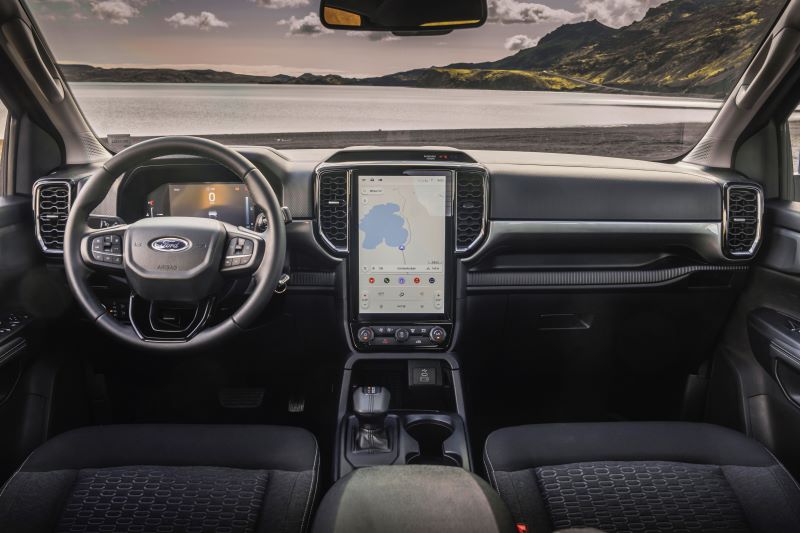
Ford Ranger PHEV: Cab & Interior
Much like the exterior, the Ford Ranger’s interior is a well-judged blend of muscular robustness with just a dash of lavishness sprinkled over the top.
While the premium sheen is enough to question whether you’d ever risk tracking muddy boots or sling tools around, it ensures the Ranger PHEV is a pleasant place to spend time.
Whereas there is little clue to the PHEV’s power source on the outside – save for a tell-tale charging flap – the instrumentation given over battery capacity status belies this from behind the wheel.
Beyond that though, the Ford Ranger PHEV enjoys the same classy interior that comfortably betters other models in the pick-up truck class. While the oversized portrait-angle touchscreen might seem a bit foreign to those better used to more humble pick-up trucks of yore, the layout is easy to navigate on the move and provides an unrivalled navigation display.
Everything feels solid and well put together, while the lofty driving position, wide centre console and chunky interior trim simply emphasises the Ranger PHEV’s ‘king of the road’ vibes.
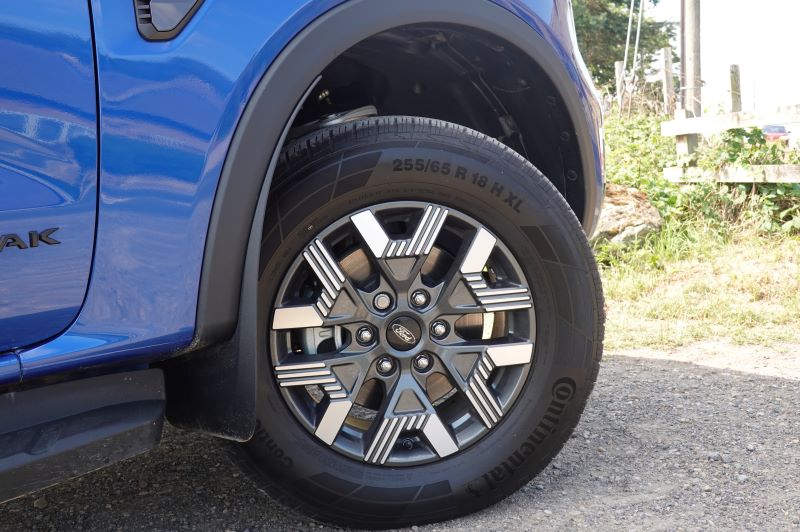
Ford Ranger PHEV: Specifications, Equipment & Trims
The Ford Ranger PHEV is available across three trim levels. These include the big-selling XLT and Wildtrak lines, indicating how Ford expects the plug-in hybrid to be an attractive proposition to the average Ford Ranger customer.
There is also an all-new Stormtrak trim available only with the PHEV powertrain, which offers a selection of cosmetic upgrades and features that are exclusive to this model.
Our test model was in Wildtrak trim, complete with optional leather seating applied. Beyond that, the Ford Ranger PHEV Wildtrak is generously equipped for a mid-range trim level.
Standard features of the Ford Ranger PHEV Wildtrak include:
- Dual-zone air-conditioning
- 12-inch multifunction display
- Heated driver and passenger seats
- Powered driver and passenger seats
- Heated steering wheel
- Ambient interior lighting
- Lane change warning assist
- Intelligent speed assist
- Wildtrak alloy wheels
- 360-degree lighting
- Wireless charging
The Ranger PHEV is also the first model in the line-up to get Pro Power Onboard, which siphons a portion of the truck’s charge to either 2.3kW (10-amp) or 6.9kW (16-amp) sources located in the load box. Using these it is possible to charge tools or power devices – such as air-conditioners, grinders or camping stoves - on-the-go, a big plus-point for those who might use the Ranger PHEV for business purposes or adventure.
Ford Ranger PHEV: Reliability
The Ford Ranger PHEV comes with a warranty that runs to 3-years or 60,000 miles from new whichever comes first.
It should be mentioned that Ford has strong reliability record with its commercial vehicles with the brand named the third most dependable manufacturer in Fleet News’ ‘FN50’ reliability survey.
Moreover, the sheer ubiquity of Ford and its commercial programme ensures there is a huge network of dealerships and service/repairs locations across the country. Our supplier here is Vertu Ford Newcastle which specialises in the sale and maintenance of Ford commercial vehicles.
Ford Ranger PHEV: Safety & Security
The Ford Ranger was awarded the maximum five-stars for crash safety by EuroNCAP.
Unlike vans – which aren’t crash tested and are instead subject to rigorous accident-avoidance scenarios – pick-up trucks are assessed on impact strength.
The latest generation Ford Ranger was tested in 2022 and earned the top five-star rating with 84 per cent awarded for adult occupant safety, while child occupant safety was 90 per cent.
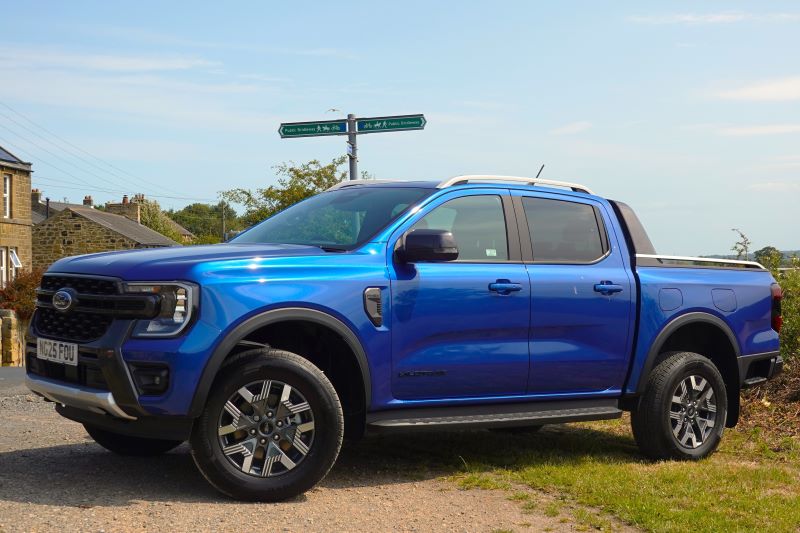
Ford Ranger PHEV: FULL VERDICT
While 26-miles of range on paper doesn’t sound like much, the Ford Ranger PHEV isn’t explicitly designed to be your new EV runaround.
Striving for more might have risked upsetting the Ranger’s equilibrium on and off-road, its payload carrying capacity and its towing ability. As the very traits that make the Ranger a Ranger, Ford has wisely chosen to play it safe.
Nevertheless, as small as the battery is, it remains a welcome complement to the torquey engine, one that also happens to whittle down emissions and boost fuel economy.
Aside from the clever bits underneath, the Ranger itself remains a class act proving stylish, well-built, tough as boots, practical and smooth to drive – adding an electric motor has done nothing to affect that.
While electric pick-up trucks from Maxus, Toyota and Isuzu are coming – not to mention an electric Ford pick-up truck within the next two years – the Ford Ranger PHEV may yet still turn out to be the best balance between reducing your running costs while maintaining all of those pivotal pick-up truck strengths.
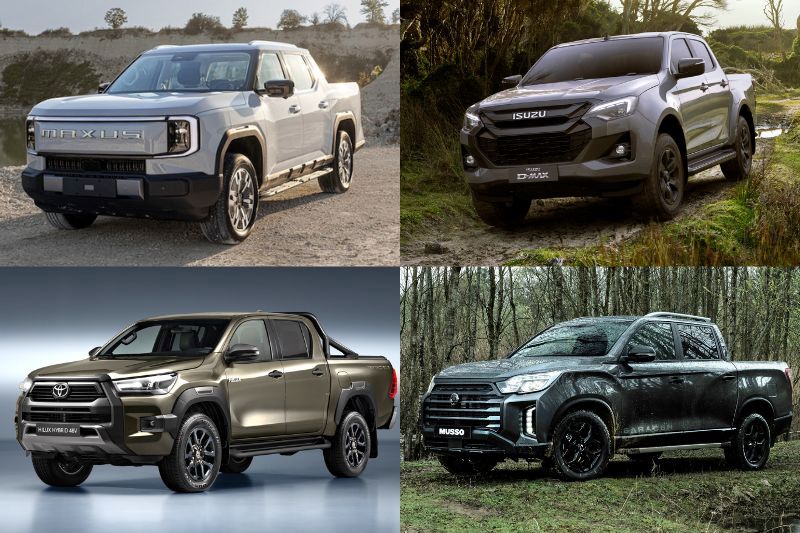
How Does the Ford Ranger PHEV Compare with Rivals?
As it stands, there are precious few alternatively fuelled pick-up trucks on the market with China’s Maxus the only manufacturer currently with an electric option.
This – the Maxus eTerron 9 – is a recent addition to the firm’s line-up and it replaces the Maxus T90, also an EV. Unlike its predecessor, which was compromised for range and performance, the eTerron 9 generates a mammoth 436bhp and 700Nm of torque from its electric motors, is longer than a Ranger and can manage 267 miles of range.
For now, the eTerron 9 is the closest like-for-like rival to the Ranger PHEV, though the Isuzu D-Max will be offered with an electric powertrain at the start of 2026. Toyota and KGM won’t be far behind with their next generation Hilux and Musso.
For the purposes of the below comparison, we have included the electric eTerron 9, plus the current diesel-powered D-Max, Hilux and Musso alongside the Ranger PHEV.
| Ford Ranger 2.3PHEV Wildtrak | Maxus eTerron 9 102kWh EV Premium | Isuzu D-Max 1.9TD V-Cross | Toyota Hilux 2.8D-4D Invincible 48V | KGM Musso 2.2TD Saracen + | |
| Powertrain | Plug-In Hybrid | Electric | Diesel | Diesel | Diesel |
| Battery Capacity | 11.8kWh | 102.2kWh | - | 48V | - |
| Engine Capacity | 2261cc | - | 1898cc | 2755cc | 2157cc |
| Max Power | 277bhp | 436bhp | 161bhp | 204bhp | 199bhp |
| Max Torque | 697Nm@2500rpm | 700Nm | 360Nm@2500rpm | 500Nm@2800rpm | 441Nm@2600rpm |
| Range [WLTP Comb] | 26 miles | 267 miles | - | - | - |
| Fuel Economy | 89mpg | - | 31.4mpg | 31.0mpg | 30.1mpg |
| CO2 [WLTP] | 71g/km | 0g/km | 235g/km | 259g/km | 246g/km |
| Fuel Tank Capacity | 70 litres | - | 76 litres | 80 litres | 75 litres |
| Length | 5370mm | 5500mm | 5280mm | 5325mm | 5405mm |
| Height | 1878mm | 1860mm | 1790mm | 1860mm | 1885mm |
| Wheelbase | 3270mm | 3300mm | 3125mm | 3085mm | 3210mm |
| Load Length | 1638mm | 1561mm | 1520mm | 1555mm | 1610mm |
| Max Payload | 1043kg | 620kg | 1105kg | 1010kg | 1205kg |
| Towing Capacity | 3500kg | 3500kg | 3500kg | 3500kg | 3500kg |
| Gross Vehicle Weight | 3500kg | 3500kg | 3500kg | 3130kg | 3400kg |

















